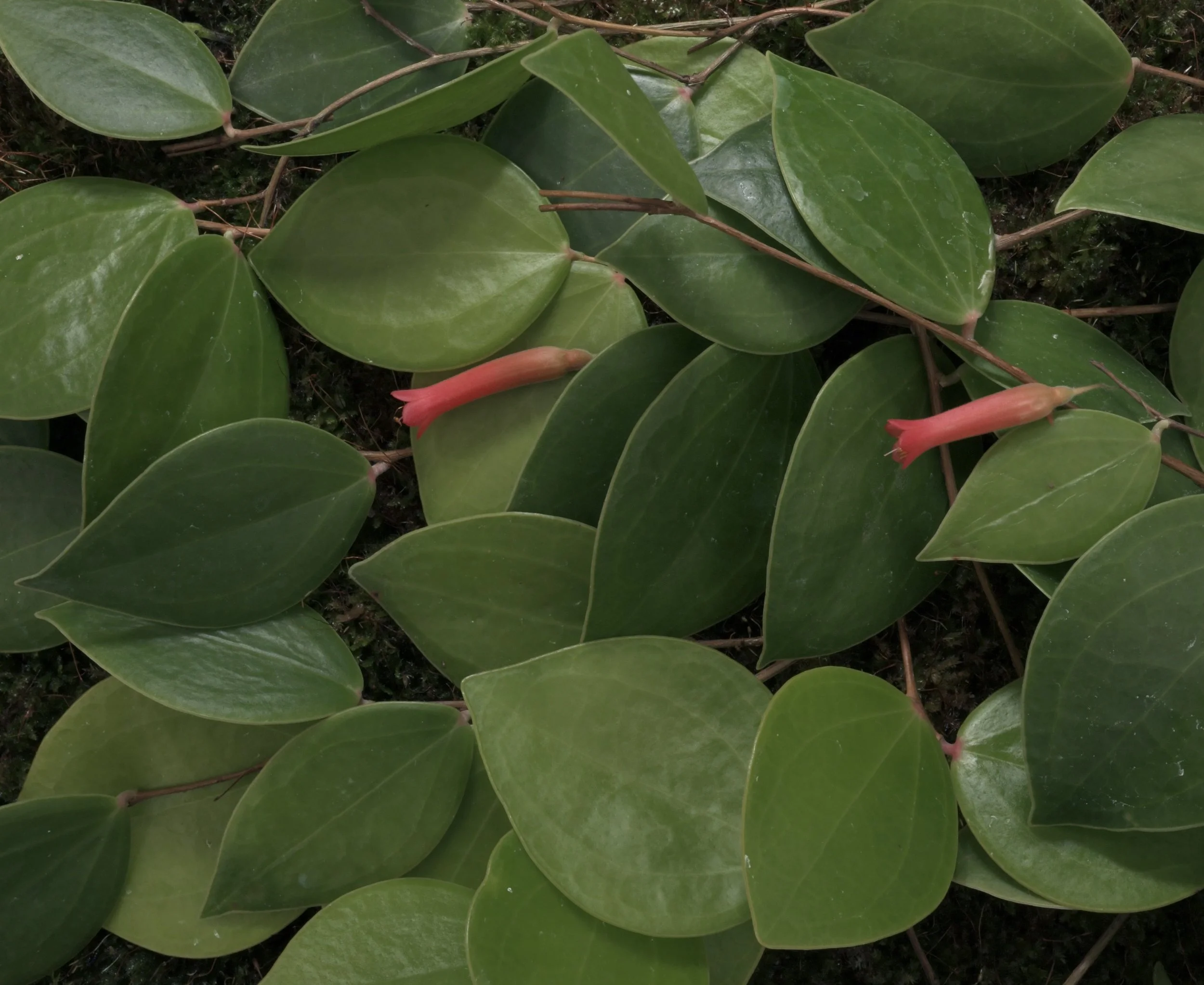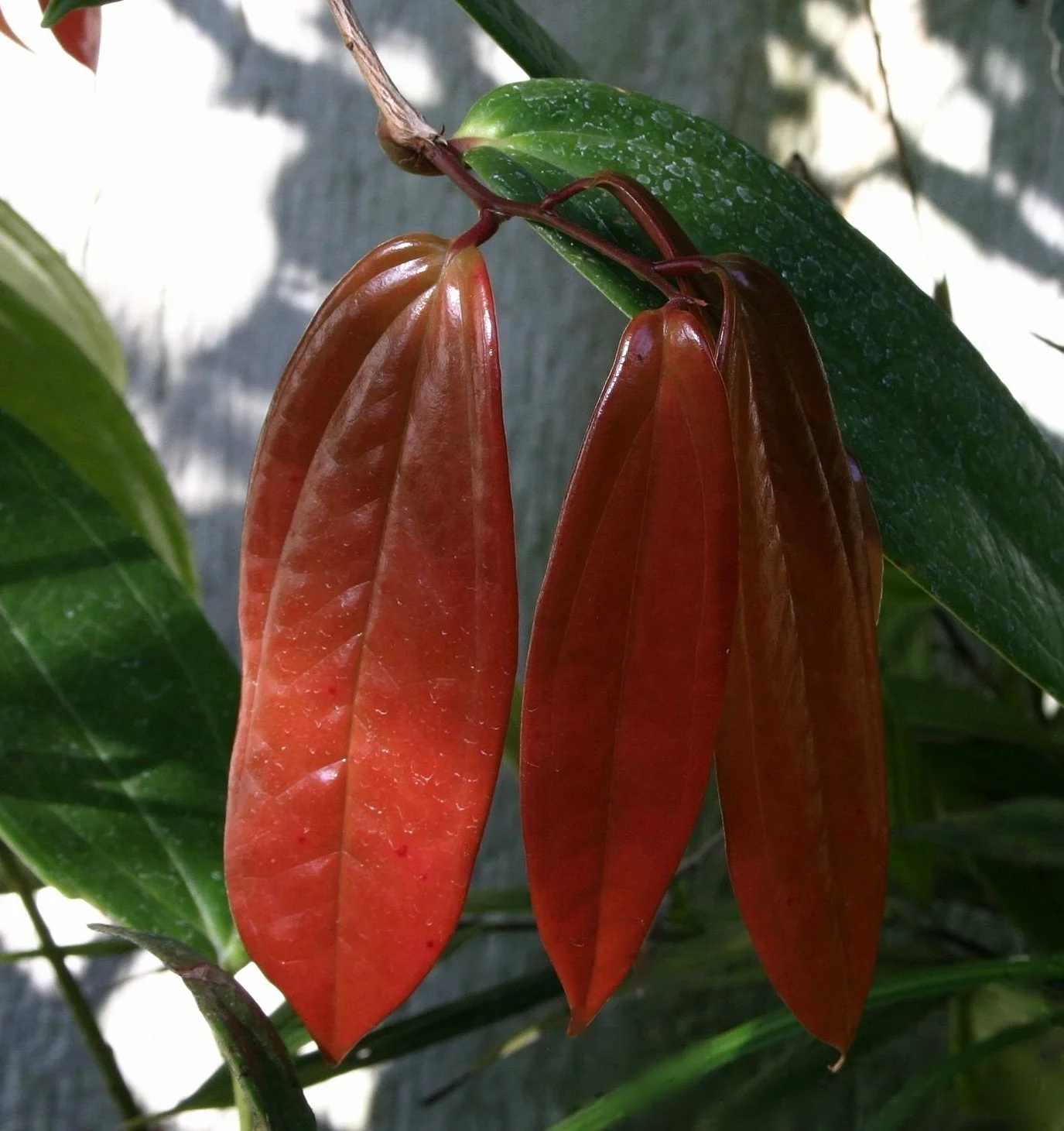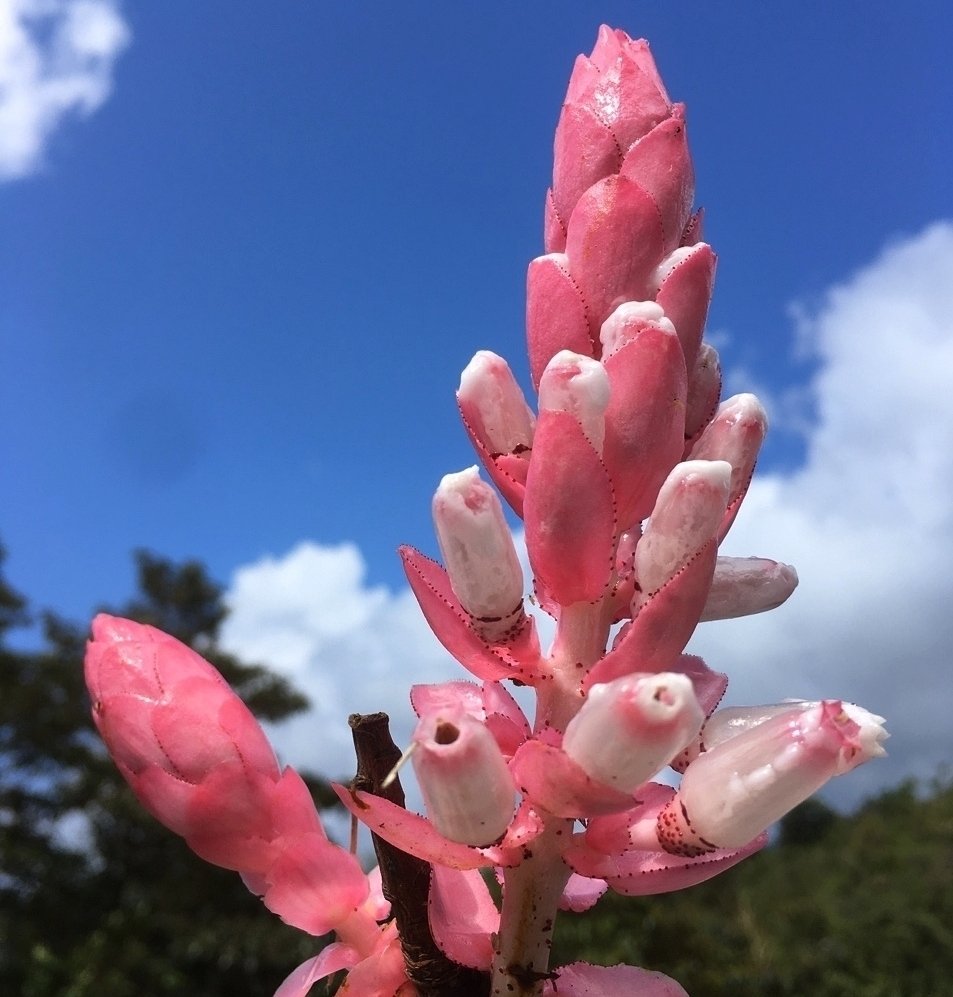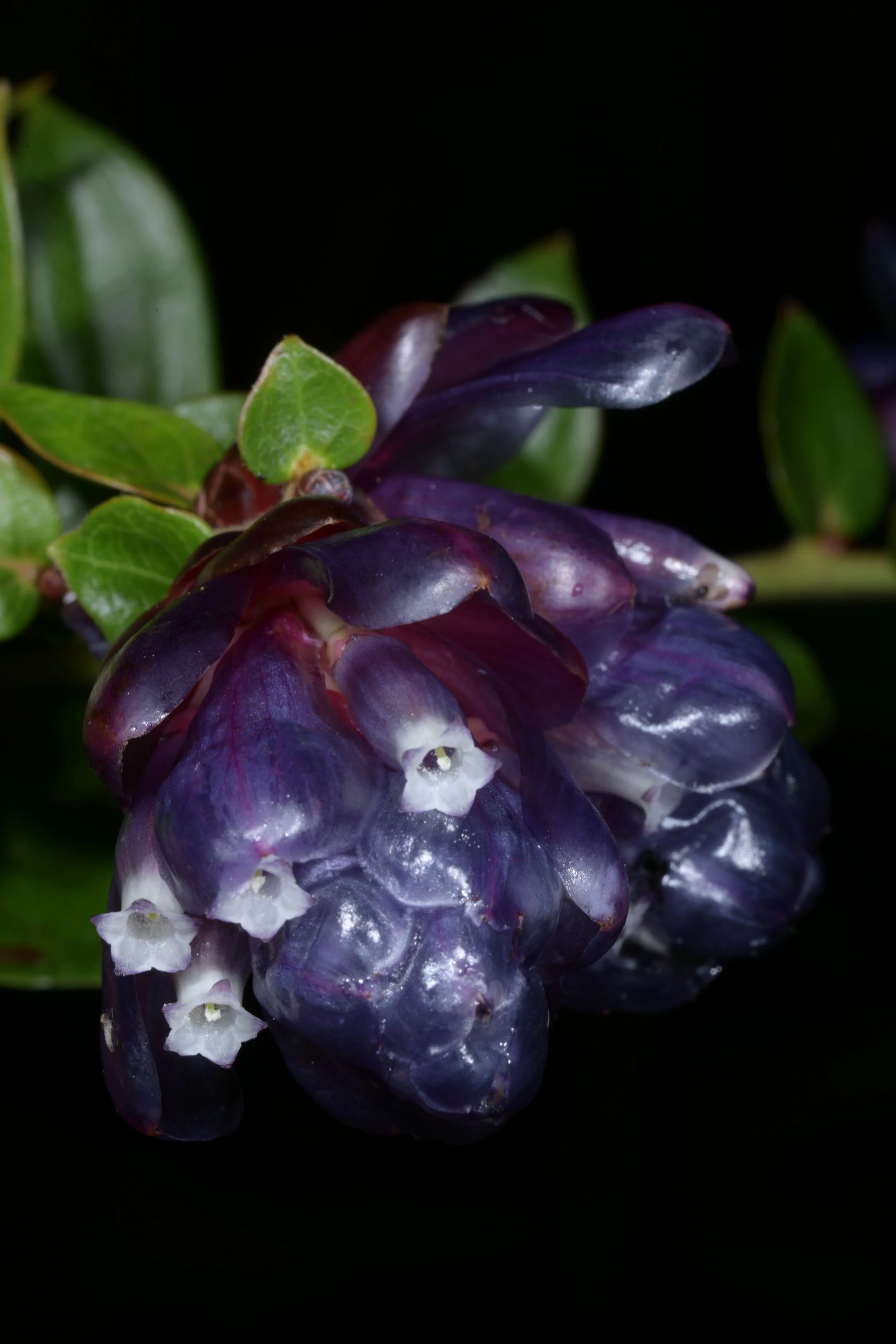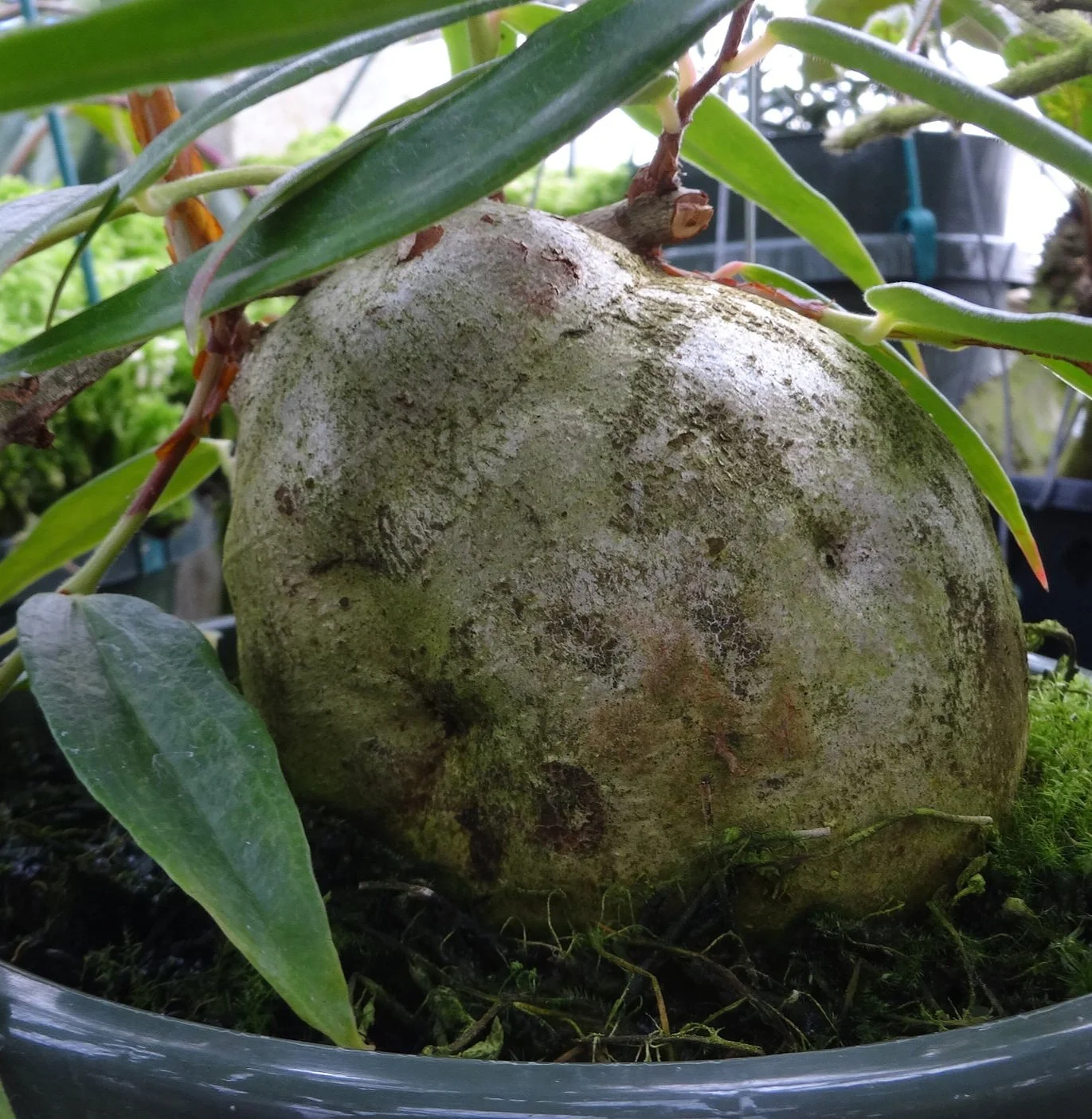Neotropical Blueberries in nature and cultivation
Crazy heathers with amazing feathers
by Jay Vannini
Flower detail on the arborescent Bejaria resinosa in nature, Cundinamarca Department, Colombia. Image: ©Jay Vannini 2021.
Flowering Andean wintergreen, Gaultheria erecta, Ecuador. Image: R. Parsons 2018.
Among the many once-obscure groups of plants that have been popularized by “the internet effect” are New World lowland tropical and cloud forest members of the Ericaceae family, now commonly known as “Neotropical blueberries”. This handle is a bit of a misnomer since many don’t actually have blue fruits, but it is somewhat less of a mouthful than “Neotropical ericaceous plants”. The Ericaceae includes quite a few well-known food plants including blueberries, cranberries and huckleberries (Vaccinium), as well as popular ornamental and medicinal genera such as rhododendrons (Rhododendron), heathers (Erica), manzanitas (Arctostaphylos) and wintergreens (Gaultheria).
Backlit climbing blueberry, Vaccinium poasanum, Montecristo, Santa Ana Department, El Salvador. Image: ©F. Muller 2018.
Showy-flowered ericaceous plants from Asia have been sought after in horticulture both in and outside of their native habitats for centuries, especially rhododendrons (incl. vireyas and azaleas) and agapetes (Agapetes). The larger New World members of the family have been somewhat ignored by gardeners until fairly recently, with the notable exception of some North American rhododendrons such as Rhododendron occidentale and R. macrophyllum. Other noteworthy U.S. native ericaceous shrubs and trees that are rapidly gaining visibility in managed landscapes are indigenous bearberries, manzanitas (both Arctostaphylos species) and madrones (Arbutus), all of which are fairly popular with gardeners in the U.S. western states, especially in California. There is a wide variety of hybrid and species manzanitas now available in nurseries throughout that state, which is also a center for endemism for the genus.
Cloud forest blueberry (Vaccinium sp.), western Panamá. Image: ©F. Muller 2018.
True New World cloud forest blueberries (Vaccinium) grow both fully exposed as shrubs and under canopy as climbers at upper elevations throughout Mesoamerica and the Andean countries. Several Central American hemiepiphytes have handsome flowers and attractive new foliage (e.g. V. poasanum and V. talamancense).
Manzanita (Arctostaphylos sp.) in fall, coastal northern California
Cavendishia adenophora, a west Colombian endemic, is a popular display plant in larger botanical gardens with cool greenhouses. The inflorescences can reach hand-span width and are spectacular if short-lived. The embossed foliage is also handsome. Plant cultivated in a California greenhouse by Tom Perlite. Image: ©Jay Vannini 2024.
A cultivated Oreanthes hypogaeus flowering the author's collection in California. This is a Critically Endangered terrestrial species known from a single, high elevation (~8,500'/2,600 masl) locality in Zamora-Chinchipe Province, Ecuador. The large leaves are extremely succulent and when plumped up are double convex in cross section. Image: ©Jay Vannini 2024.
A flowering Snowberry, Gaultheria myrsinoides, growing in páramo at Sumapaz NP, Cundinamarca Department, Colombia. Ranging from northern México continuously at high elevations throughout Central and South America to Argentina, this species has the widest geographical range of any Neotropical ericac. Image: ©Jay Vannini 2024.
Psammisia williamsi immature flowers. Fortuna, Chiriquí Province, Panamá. Image: ©F. Muller 2020.
Cavendishia bracteata, San Pedro Carchá, Alta Verapaz Department, Guatemala.
Oddly enough, the beautifully-flowered Mesoamerican and northwest South American species of the family were largely overlooked during the Victorian plant-collecting craze. One notable exception was the James Veitch & Sons introduction of the common, variable and very widespread Cavendishia bracteata (as C. acuminata) from accessions made in Colombia by Richard Pearce in the early 1860s. This species first flowered in cultivation in England in 1868. Since most Neotropical blueberries are not suited to traditional “stove house” conditions and a number grow to rather large sizes, they did not really become visible in cultivation until fairly recently. Dr. James Luteyn, a montane plant specialist with the New York Botanical Garden, has been instrumental in educating the public about this group, and propagations of his living collections at the NYBG that were shared with other botanical gardens such as Atlanta and Marie Selby are the source of some of the material currently cultivated in the ‘States.
Flower detail, Ceratostema amplexicaule, California greenhouse. This species can be trained as an upright shrub and flowers almost year-round when mature. Both flowers and fruit are edible in this species. Image: ©Jay Vannini 2018.
Ceratosteme alatum flowering in a Caifornia greenhouse. This is a Neotropical blueberry species that performs well both as a pot plant and planted outdoors under cool subtropical conditions.
These plants, like some true heathers (Erica species) in the Old World, can dominate landscapes at high elevations throughout the Neotropics. They are particularly common on poor, acid soils in cold, wet, windswept environments such as elfin forests and páramo. While many are prostrate or ground hugging at exposed sites, a few are small trees (e.g. Bejaria) while others sprawl up and out from pockets of shade or from roadcuts to present impressive spectacles when in full flower (Satyria and Orthaea species).
The Neotropical blueberry genera that are most popular and reasonably well-represented in cultivation include (alphabetically): Anthopterus, Cavendishia, Ceratostema, Disterigma, Macleania, Psammisia, Satyria and Sphyrospermum. Only two genera – Cavendishia and Macleania – have species that can be deemed “fairly common” in ornamental horticulture. Most of the other genera are still very under-represented in both public gardens and private collections, with approximately 125 species in cultivation and only a few readily available from commercial sources. Besides the material that has been transferred from botanical gardens to private collectors over the past 15 years or so, introductions have also been made by “tourist” plant collectors visiting range countries and – more recently – by specialty nurseries in Ecuador and Colombia. Even though many species possess very attractive inflorescences, they are generally not popular garden plants in their countries of origin, with a few exceptions such as Cavendishia callista, C. nitens and C. adenophora.
A remarkable, apparently undescribed Ecuadoran cloud forest Ceratostema sp. aff. zamorana that combines glandular extrafloral nectaries on its leaves, with a large, globular caudex and very showy blush magenta and violet black 2.25”/6 cm corollas. Author’s collection. Images: ©Jay Vannini 2020.
Beautifully embossed leaves on a flowering/fruiting Cavendishia axillaris in western Panamá. Image: ©F. Muller 2018.
In recent years, much has been made by the popular press of apparent scientific interest in the group as a possible source of new “superfruits”, in particular two species in limited ornamental cultivation in the U.S. and the EU, Anthopterus wardii and Cavendishia grandifolia. Given that edible Neotropical blueberries (including both flowers and fruits in a few species) are rather bland in taste and, high levels of antioxidants notwithstanding, I would not expect them to challenge their familiar cultivated relatives - much less mangosteen (Garcinia mangostana) - as a consumer preference anytime (ever). Caution and common sense should be used when sampling any fruit of an Ericaceae not positively known to be edible. Obviously, fruits from plants recently treated with pesticides should not be eaten at all.
The genus Orthaea has a number of extremely attractive species, mostly occurring at higher elevations and ranging from central Guatemala to Perú. Unfortunately, their imposing size makes them poor candidates for most growers. Cultivated plants are known from public gardens in Canada, Scotland and private collections in Guatemala.
Besides their often eccentric, candy-like, striking inflorescences and flowers, many Neotropical blueberries can also exhibit beautiful foliage with heavily embossed leaf veins. This is particularly evident during new leaf flushes in the larger species, which are often bright red, orange or pink with a lacquered appearance. The very thick-textured, glossy leaves of many of the larger satyrias, psammisias and cavendishias are definitely an added attraction to growers. Large, vividly-colored new leaves and steady growth are indicative of good plant health.
Orthaea brachysiphon growing at cloud forest edge,Zacapa Department, Guatemala. Image: ©J.J. Castillo 2018.
Several Neotropical blueberries from the NW Andes have tasty fruits that are consumed in their countries of origin. Above, ripe berries on a cultivated Cavendishia adenophora in California. These fruits are surprisingly sweet and, together with other species of Cavendishia with violet berries, are known as uvas (grapes) in Colombia. Image: ©Jay Vannini 2024.
Shown above, emergent leaves on two very attractive Panamanian Neotropical blueberries growing outdoors in Guatemala, a Psammisia species on the left and a large Satyria on the right.
The aptly-named Cavendishia callista (from the Greek “kalliste” = most beautiful), shown above, has one of the widest ranges of any Neotropical blueberry, from Chiapas, México southeast through the highlands of Central America to Venezuela and Brazil and southwest to Ecuador. Left, the striking inflorescence of a plant at the type locality near Cobán, Alta Verapaz Department, Guatemala and right, at Fortuna, Chiriquí Province, Panamá. Image left: ©Jay Vannini 2019. Image right: ©F. Muller 2018. Inexplicably, this very attractive species is still rare in cultivation. Some plants grown under this name in the U.S. appear to be forms of the more common C. bracteata. Several of the northern ecotypes are relatively compact and can be flowered in fairly small pots.
The common, fairly compact Panamanian epiphytic Cavendishia allenii in nature in the Caribbean lowlands of the eastern part of the country (left), and in cultivation in the author’s collection in Guatemala (right). This species is well-suited for cultivation in a hanging pot under warm to intermediate conditions. Images: ©Jay Vannini 2019.
Two gorgeous examples of inflorescences of high cloud forest Andean Cavendishia species, photographed in nature by and ©Gary Yong Gee in Tatamá NP in Risaralda Department, Colombia. Above left, C. angustifolia and right C. nitens.
Anthopterus wardii flowers, California greenhouse. This popular species is fairly compact in cultivation and is very rewarding to grow. Its bright violet-blue fruits are also very attractive. Image: ©Jay Vannini 2018.
Neotropical blueberry flowers are mostly hummingbird-pollinated in nature although they will attract insects in some greenhouses. My experience is that they generally due to not produce viable fruit in cultivation in closed houses, but commonly do so if spelled or grown outside in areas where hummingbirds exist.
Many Neotropical blueberries are easily cultivated under intermediate conditions, and the smaller forms can readily be grown to flowering sizes in 6-10”/15-25 cm pots. Constant high humidity is advantageous in their culture. They are excellent companion plants for cool and intermediate-growing orchids in glasshouses, and some species can be cultivated in well-lit/ventilated Wardian cases or very large terraria. Some of the larger cavendishias, psammisias and satyrias will require much larger pots and far more space to flower properly, although careful pruning can prompt flowering on compact plants. A few species that occur in the lowlands are well-suited to warm tropical conditions, including Cavendishia allenii, several Macleania species and Satyria panurensis (see below). Some very high elevation forms can be grown outdoors year-round in subtropical climates like the San Francisco Bay Area and elsewhere.
Neotropical blueberries are fairly simple to propagate from young woody cuttings. I usually remove some lower leaves, treat the base of the cutting with Clonex rooting gel, plant in barely damp sphagnum and bag the result, but friends have had success with some species by just inserting fresh cuttings - leaves and all - into damp sphagnum under cool, humid greenhouse conditions in northern California.
The micro-miniature Disterigma empetrifolium growing in large colonies on road cuts in Chingaza NP, Cundinamarca Department, Colombia. Image: ©Jay Vannini 2021.
Corolla detail on a young Ceratostema rauhii, a high elevation pendent blueberry from northwestern Perú and southern Ecuador. This is one the world’s best hanging basket plants when well-grown. Both foliage and flowers are fantastic.
Two Sphyrospermum species are shown above in nature and cultivation. Left, an unidentified species from Ecuador (Image: R. Parsons) and on the right, the ubiquitous, wide-ranging S. buxifolium in cultivation in Guatemala. This genus is perhaps the easiest among all Neotropical blueberries to grow in small plastic pots or hanging baskets.
An added attraction to several genera is the early formation of solid caudexes or lignotubers that can be lifted over time for display purposes. These are particularly evident in the genus Macleania which has a few species, like M. rupestris and M. insignis, that have made the cross-over into the succulent collectors’ camp. These structures can attain quite large sizes in nature, and I have seen epiphytic macleanias in Guatemala and Panama with basketball-sized caudexes adpressed to tree trunks. Many epiphytic ceratostemas will also produce large woody tubers at a fairly young age, making them superb display subjects for gardens and conservatories.
Two examples of robust lignotubers on Neotropical blueberry genera are shown above. Left, a very large caudex on a wild Macleania insignis growing in cloud forest at San Pedro Carchá, Alta Verapaz Department, Guatemala and right, Ceratostema sp. aff. zamorana growing in a California greenhouse. Images: ©Jay Vannini 2018-2020.
A well-flowered Cavendishia megabracteata, Chiriquí highlands, western Panamá. Image: ©F. Muller 2020.
A very large Satyria panurensis flowering in lowland tropical rainforest, Ngäbe-Buglé Comarca, Panamá. This species can achieve massive dimensions under these conditions, with some plants cascading more than 30’/9.25 m from the canopy. Image: ©Jay Vannini 2018.
Growing media or this group should be well-drained and neutral to acidic. Potted plants grow well in both NZ sphagnum moss and fine conifer bark mixes. Small amounts of sphagnum peat can be added to increase moisture retention in bark mixes, but the media should drain freely for best success. They are moderate feeders and respond well to either liquid feeds of soluble fertilizers suitable for epiphytes or time-release products such as Nutricote. Plants dropping leaves and terminal growth die-back usually indicate severe root loss. Cuttings should be made as soon as possible for backups wherever possible to avoid total loss of a species in your collection if – for whatever reason - it blows up at valuable specimen size.
Above, three southern Central American-Panamanian lowland rainforest epiphytic species suitable for cultivation under warm tropical conditions. Left to right, Cavendishia allenii, Macleania eiphytica from Guna Yala Comarca, Panamá and Satyria panurensis at Salaquim, Alta Verapaz Department, Guatemala. All three of these species are in limited cultivation in the U.S. Images: ©Jay Vannini 2018.
Satyria cf. ventricosa, Fortuna, Chiriquí province, Panamá. Image: ©F. Muller 2018.
Epiphytic plants are best grown in hanging pots or durable baskets. Presumably, many epiphytes can also be grown as mounts on cork plaques and branches in buoyant, perhumid environments but I have not tried this technique for any species other than Disterigma panamense.
Central America has a respectable number of Neotropical blueberry species, and I grew several dozen forms from Guatemala and Panama for many years when I lived in the former country. In California, I currently grow ~25 species from nine genera, including both Mesoamerican and northwest Andean species, and continue to add slowly to this collection as more attractive species become available.
Flower cluster of Satyria boliviana in a California greenhouse. Endemic to the uplands of central and western Bolivia, this is one of the southernmost epiphytic members of this group.
Two superb Cavendishia species in flower; a cultivated C. micayensis in a California greenhouse above left, and C. sp. cf. capitulata right in Fortuna, Chiriquí Province, Panamá. Image right: ©F. Muller 2020.
Many of the finest species of Neotropical blueberries remain elusive in horticulture, but an increasing number of uncommon, showy-flowered Andean species are finding their way into growers’ hands with each passing year. Besides those shown here, a few species suited for pot culture that should be high on the “must have” list of anyone interested in this group of plants include: Cavendishia adenophora, C. erythrostegia, C. nitens, C. tarapotana (plants sold thus far in the U.S. as this species appear to have been misidentified by vendors), Psammisia dolichopoda, P. sclerantha, Thibaudia litensis and Vaccinium talamancense.
Bejaria resinosa flowering in misty páramo near Bogotá, Colombia with frailejones (Espeletia sp.) ghosting in the background. Image: ©P. Rockstroh 2019.
Three interesting species of Disterigma from northwest South America and eastern Panamá. Left to right, D. empetrifolium (Image: R. Parsons), the epiphytic D. panamense (formerly D. luteynii) and D. rimbachii in cultivation as a ground cover in coastal northern California. This species performs well as a garden plant in the San Francisco bay Area, tolerating full sunshine and dry heat during the summer and below freezing and wet weather in the winter. Image left: ©Ron Parsons 2018. Center image and right: ©Jay Vannini 2018.
Satyria meiantha growing roadside, Purulhá, Baja Verapaz Department, Guatemala. Image: ©Jay Vannini 2018.
Well-flowered Psammisia ramiflora in nature in Panamá. Image: ©F. Muller 2020.
Macleania rupestris growing in páramo near Bogotá, Colombia. Image: ©P. Rockstroh 2018.
All content ©Exotica Esoterica LLC® 2018-2025, ©Fred Muller 2018, ©Peter Rockstroh 2018, and ©Ron Parsons 2018
Follow us on:




